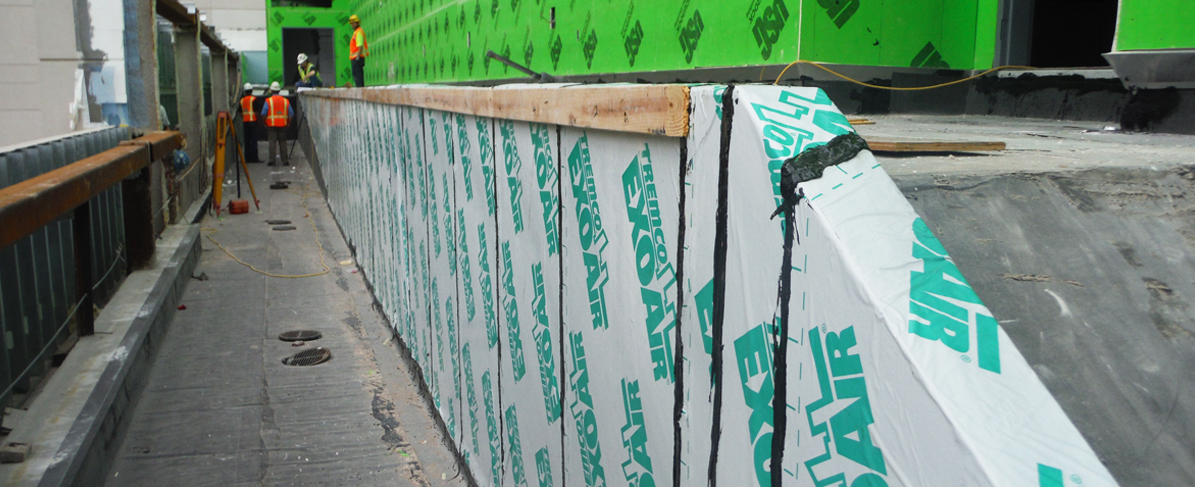As research and testing has expanded in recent years, so too has the awareness around the importance of connectivity for air- and water-tight buildings. As my friend and fellow building scientist, Gene Keeton, says, “There’s no good reason for a building to leak.” The preconstruction, or pre-con, meeting is the first step to ensuring that the real-world construction adequately matches the design intent. Learn more about the critical components of a pre-con meeting to ultimately confirm proper product selection and sequencing of the trades so that your project is completed correctly the first time.
What is the building enclosure preconstruction meeting?
The preconstruction meeting, not to be confused with a separate preinstallation meeting, is an opportunity for the design team, consultants/commissioning providers, owner, construction manager (CM) or general contractor (GC), as well as all building enclosure trades and respective manufacturers, to establish clear communication and collaboration prior to starting construction. The meeting should be held on-site and prior to the submittal of the shop drawings, once the product selection has been completed so that the manufacturers, trades, and design professionals can all attend.
During the preconstruction meeting, the group should complete the following:
- Review all project drawings and system specifications to determine if the proposed details can be constructed as intended by the designer/specifier.
- Confirm product selection and compatibility with each trade.
- Examine construction details, including tie-in areas to ensure they are air- and water-tight.
- Identify sequencing of all trades with a comprehensive construction schedule which simulates construction from the ground up.
- Discuss any other project-specific considerations, such as mock-ups, performance testing, and enhanced details required for specified building enclosure warranties.
 Covering these details thoroughly ensures that the design can be properly executed and on-time, while promoting collaboration and project ownership with the installing trades. The conversation should be clear on each company’s and individual’s responsibilities and timelines to mitigate any ambiguities in the construction documents, such as the drawings and project manual. It also helps identify constructability concerns, confirm sequencing, and review the “by others” transitions between systems. The pre-con meeting should be part of the CM/GC quality assurance and quality control protocol, which helps minimize risk for the owner and design/build teams and ensures the performance of the constructed building will meet the owner’s expectations.
Covering these details thoroughly ensures that the design can be properly executed and on-time, while promoting collaboration and project ownership with the installing trades. The conversation should be clear on each company’s and individual’s responsibilities and timelines to mitigate any ambiguities in the construction documents, such as the drawings and project manual. It also helps identify constructability concerns, confirm sequencing, and review the “by others” transitions between systems. The pre-con meeting should be part of the CM/GC quality assurance and quality control protocol, which helps minimize risk for the owner and design/build teams and ensures the performance of the constructed building will meet the owner’s expectations.
Proper Product Selection
The contractor's responsibility during the pre-con meeting is to go through every single step of the construction process and discuss the specific sequencing and overlap of products. Can an installer apply onto the prepared substrate or transition onto other trades’ work as designed? Will the installation/application area be ready in time for the selected product, or is the substrate adequately cured? Can a material or assembly be applied in the current weather conditions at the time of installation? How are dissimilar materials coming together? Has compatibility or adhesion testing been conducted at connections and transitions? Following this conversation, if there is a necessary shift, then all parties should be made aware and agree with the discussed solution(s), so that the shop drawings and resubmittals, if any, can reflect the change.

Sequencing of Trades
Between the contractor, trades, architects and engineers, and consultants/commissioning providers, there is a lot of potential for miscommunication and a detrimental disconnect in the project coordination. The building enclosure preconstruction meeting should enable the group to build the structure as a cohesive whole, not just one piece at a time. For sequencing, subcontractors and the assembly manufacturer need to be aware of and monitor which trades are going to follow up behind them. What are those trades doing to the already installed and maybe already inspected systems? For example, penetrations to an existing waterproofing membrane, which was tested and approved, could severely damage the integrity of the building enclosure. So how is the contractor managing those hazards? This process should be clearly outlined during the preconstruction meeting to prevent unnecessary leaks, and product failures or malfunctions.
After the Meeting
The building enclosure preconstruction meeting is only going to be effective if each party maintains their commitments through the duration of the project. Therefore, the topics covered and decisions made should be documented and sent to any groups not present. The documented changes identified in the preconstruction meeting should be reflected in shop drawings and should be reviewed in the subsequent preinstallation meeting as well. Lastly, regular follow-ups and inspections are a must to verify the product selection, application and sequencing is carried out during the construction and installation phase. If you have any questions or need a second opinion, never hesitate to contact a building science specialist or building enclosure consultant to assist. Learn more about building enclosure commissioning (BECx) and its benefits here.






